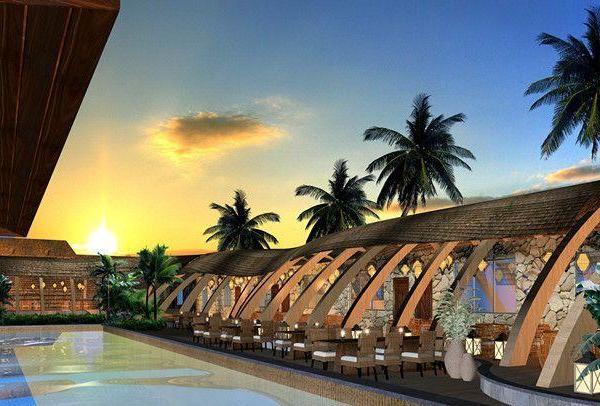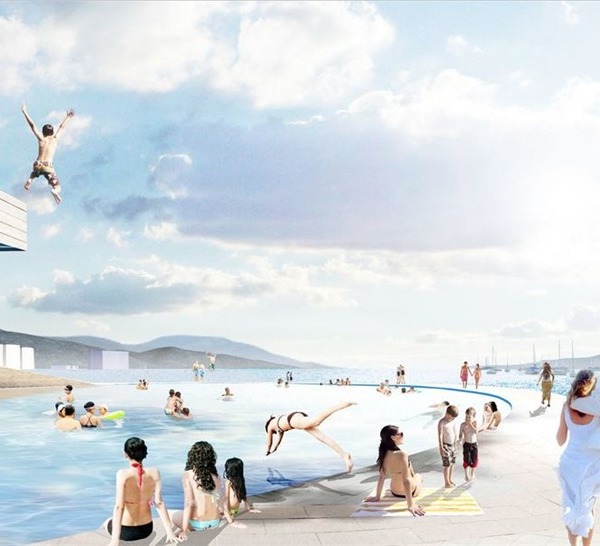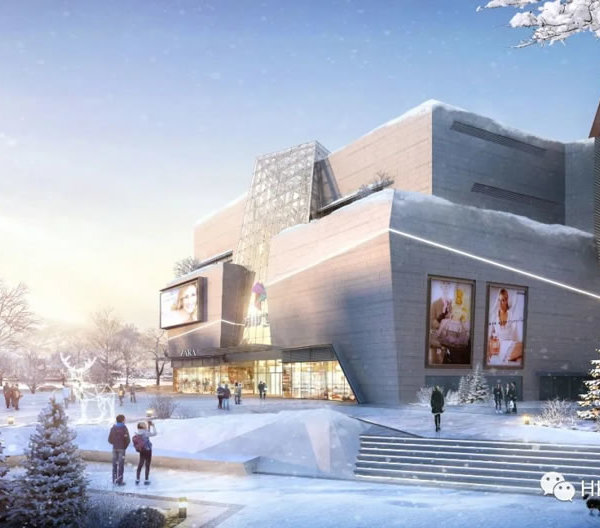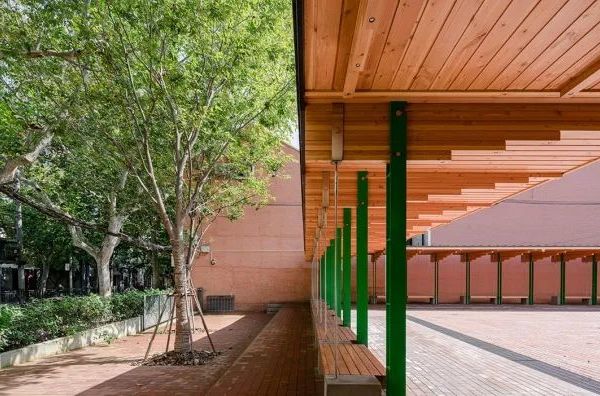“放眼当今的公共景观,也许很难再找到像美国国家广场这样被频繁使用的大规模绿地。它被誉为美国的“前院”,每年约有2500万名游客在此举行庆祝或示威活动。因而,草地本身的修复需要一个经过深思熟虑的解决方案,以实现长期生存的能力与可持续性。该方案为土壤管理、播种以及草坪的轻微抬升制定了战略性的举措,并通过特殊的灌溉方法减少了75%的饮用水消耗。尽管这是一个看上去简单的技术解决方案,但当它被应用至近31英亩的土地面积上时,其带来的积极影响便超出了这座宏伟的广场本身——这是一个可以扩展到全国公园景观的示范性方案。” – 2020年评审委员会
“Lawns these days can be polarizing, and perhaps none more so than the National Mall, which is often considered the country’s front lawn and plays host to celebrations and protests to the number of some 25 million annual visitors. Restoration of that turf surface has thus warranted a considered solution for long- term viability and sustainability that integrates strategic seeding and soil, a subtle crowning to improve drainage, and an irrigation approach that reduces potable water usage by 75 percent. While the technical solutions may seem straightforward, when expanded across nearly 31 acres of surface, their impact can expand beyond the scale of this grand, green monument to well-used parks across the nation.” – 2020 Awards Jury
国家广场(National Mall)可称得上是美国最重要的文化景观,它被誉为美国的“前院”,每年接待大约3000万名游客,并举办约3000场特别活动。人们来到广场上展示言论自由、纪念国家退伍军人、为自己发声、亦向国家对自由与平等的承诺致意。
而在世纪之交,国家广场的景观面貌曾一度陷入令人尴尬的局面。改变此种现状的方法并非只是种植草坪这么简单,而是要创造一个全面的景观解决方案以维护并保存国家的文化资产,并为之赋予可持续性和复原能力。国家广场的恢复所展现的不仅仅是景观层面的美,更是隐藏在其可见表面之下的庞大工程,以及为了维护和使用所竭力付出的实践。这是一个将美感、保护措施、细节与功能性巧妙融合的项目,在维护国家珍贵遗产的同时,也为景观设计的实践提供了优质的案例。
The National Mall is arguably the most culturally important landscape in the United States. Known as America’s “Front Yard,” The Mall hosts nearly 30 million visitors and 3,000 special events annually. Millions of people visit The National Mall to demonstrate freedom of speech, commemorate presidential legacies, honor our nation’s veterans, make their voices heard, and celebrate our nation’s commitment to freedom and equality.
By the turn of the century our Nation’s most significant landscape had fallen into a disgraceful state. The project that ensued was not merely about planting grass; it was about creating a comprehensive landscape solution to protect and preserve our Nation’s cultural asset to achieve sustainability and resiliency. This story is not solely about the beauty of the landscape, but how what you see on the surface reflects what has been constructed below the surface and the establishment of best practices for maintenance and use. It is the artful compilation of beauty, preservation, detail and function that makes this an award-worthy landscape in addition to our national treasure.
▲创造和恢复历史:项目团队在国家公园管理局的委托下修复了国家广场的草坪和土壤,通过对细部、基本景观结构以及可持续性的关注,使美国最重要的文化景观恢复了原有的庄严感。Making and Restoring History: Our team’s restoration of the National Mall turf and soil for the National Park Service allows our nation to once again be proud of America’s most important landscape through a focus on the details, the underlying landscape structure and sustainability. © The National Park Service
任何设计都有它最主要目的,即它所要解决的问题。初看之下,该项目的设计目标十分具有挑战性,而同时又非常直接了当:通过重新种植草皮来恢复华盛顿国家广场的庄严感。然而就像大多数情况一样,完成这个任务并不像看上去那么容易。需要解决的问题涉及美观性、结构性、可持续性和功能性四个方面,只有提出全面的解决方案,才能最终实现一个具有适应力和生存能力的国家广场,同时证明广泛启用公款投资的合理性。
场地位于华盛顿西北3街和西北14街之间,面积为135万平方英尺(约31英亩),由人行道和八块草坪构成。重建项目的完工距今已有7年的时间,广场也已经历了数以千计的活动、迎接了上千万名游客。在今天,它仍然保持着最理想的状态,并作为美国最重要的景观而存在。
设计的首要目标是重新找回国家广场的壮观美。多年以来的过度使用和维护资金的缺乏使广场的状态每况愈下:草坪日渐稀疏,且混满了杂草和泥巴;原本应当干净清晰的草地边缘磨损严重,与参差的砾石和种植区混淆在一起。设计团队的总体目标是在广场的总长度上创建连续的绿地序列来作为国会大厦的前场。通过简单而有效的技术,草坪的高度得到增加,从远处看时,人们的视线将不再受到人行道、街道和车辆的干扰。加高草地的举措一方面带来了不间断的视觉感受,另一方面也确保了有效的排水。草坪的边缘采用符合ADA(美国残疾人法案)标准的花岗岩铺设,并在尺寸上做了谨慎的调整,以确保其宽度与广场的整体尺度相符合。最后,在附近的草地农场,还根据该区域的土地状况和承载条件培育了特殊的混合种子,以完全地适应既有的场地环境。
在地面上实施的三项举措是本次项目获得成功的基础,而草地的长期健康则取决于地面之下的结构。项目团队包括来自商业景观领域、体育景观领域和学术界的土壤科学家,共同制定了适用于该场地的最佳规范。场地所需要的是一种混合型的土壤,首先要能够承受压实,具备对空气过滤和耗水的敏感性,同时还能尽可能地降低对化肥和除草剂的需求。以上这些目标在许多方面都具有互斥性,而项目团队为此提出的方案是“粗砂混合”,即其中60%的砂石用于抵抗压实,40%的有机物用于维持草皮的健康生长。团队研究了多种具有不同颗粒物和有机物含量的混合土壤方案,以得出最佳的毛细状结构和pH值维持时间、有机物密度、抗压实度以及每种土壤提供适宜空气、水、营养物质和渗透性的能力。设计要求将现有土地替换为深度为3英尺的工程土壤,这种土壤具有足够的渗透性和有机物质,能够在支持草坪生长的同时将水分维持在地下结构当中。
可持续性是项目的另一个重要目标。主要的问题是:如何以可持续的方式种植草坪?从本质上说,草皮并不是一种典型的可持续解决方案,但在该项目中却是唯一适合广场文化属性的选择。因而,设计需要解决草皮维护的核心要素:“水”。团队提出的方案致力于改善水质、减少雨水径流、抵御洪水侵害、减少华盛顿污水处理系统的负担、降低对饮用水的依赖,同时在一个需要灌溉的气候中成功地种植草皮。人行道、草皮块与花岗岩路缘进行了在高度上进行了分级,并在地下设置了一个新的排水层。排水层的水将被引入四个蓄水池,总存蓄量相当于100万加仑的雨水径流,在经过过滤处理后可被重新用于灌溉。项目带来的可持续发展效益包括减少75%的饮用水灌溉消耗量。虽然草皮的固碳潜力仍有待考察,但根据目前的研究,每平方英尺的草皮每年的固碳量约为2.3克,在土壤中的含碳量达到饱和之前,其固碳的效力大约可以保持约180年。整个广场范围约铺设有78.4万平方英尺的草皮,可使每年的固碳量达到将近2吨。
形式与功能间的权衡是设计中一贯被讨论的主题。在该项目中,二者无疑需要齐头并进。国家广场的基本功能是为人们提供集会的空间,其每年要举办的活动数量是全年天数的两倍以上,全美国几乎找不到第二个被使用得如此频繁的公共景观,且该空间的使用受到宪法第一修正案的保护。与此同时,国家广场作为具有历史意义的文化资产,必须得到有力的保护。它是公民信仰的象征,代表着言论、集会、宗教和表达的自由,以及公民向政府请愿的权利,在这个意义上,形式是整个设计的基本所在。那么,如何让一处景观能够满足未来几代人的崇高愿望?这一问题的解答根植于设计团队和国家公园管理局为广场制定的活动运营和维护手册,并由时任内政部长Ken Salazar(ASLA荣誉成员)下发的文书提供支持。国家公园管理局需要明确执行文书中规定的政策,以确保新草坪的使用寿命。草地保护策略明确了草皮种植的准备、保护和恢复工作,并规定了具体的休眠时间、重量限制以及半透明防护板的放置。此外,对草坪上的临时结构也给出了相应的指导,以确保铺地区域能够承载帐篷、巨幕和舞台的搭建。该手册还提供了以季节为依据的肥料使用指南,罗列了与使用低影响除草剂、覆盖茅草、修剪、播种和维修需求相关的参数,将管理、政策、许可和维护措施全部纳入到一个综合性的文件中。2013年,《景观建筑杂志》引用了当时国家公园管理局高层Patrick MacDonald的论述:“在我从事公园服务的35年生涯中,参与制定如此详实的支持性文件还属首次。”
国家广场的重建工作可追溯到2009年,它是三期设计和建造工程中的第一阶段。新的广场如今已经举办过两次就职典礼、七次国庆节庆祝活动以及不可计数的示威和游行活动,并为上千万名游客以及华盛顿特区的居民提供了理想的休闲目的地。设计团队中的每个成员都将这次保护国家地标的工作视为一份特殊且巨大的责任,而重建国家广场的项目也向我们证明了如何以最佳方式来尊重和保护对于一个国家而言有着非凡意义的公共开放空间。
▲状况不佳:作为美国的“前院”,国家广场的既有状态十分不理想。不可持续的维护方法和不完善的公共使用标准造成了严重的破坏和草地复原能力的丧失,具体表现为土壤过度压缩、排水不畅、草皮斑驳以及灌溉中断等。Not a Good Look: Existing conditions of America’s “front yard” were bleak. Unsustainable maintenance practices and a lack of public use standards created a cycle of heavy damage and truncated recovery. Symptoms included soil compaction, poor drainage, inconsistent turf, and broken irrigation. © The National Park Service
▲修复美国的“前院草地”:项目涵盖了设计和工程服务,目的是整修国家广场的八个中央草坪块和花岗岩路缘,其中包括建造无障碍设施、花岗岩人行道以及排水方面的改善。Fixing America’s “Front Lawn”: The project scope included design and engineering services to refurbish the National Mall’s eight central turf panels, granite curb edges including ADA accessibility, granular walkways, and storm drainage improvements. © The National Park Service
▲顺应时事的进程:项目的第一阶段更换了西北3街至7街的草坪,及时赶上了奥巴马总统的第二次就职典礼;第二和第三阶段更换了西北7街至14街的草坪,赶上了特朗普总统的就职典礼。If You Build It, They Will Come: Phase 1, we replaced lawn panels from 3rd to 7th Streets NW in time for President Obama’s second inauguration. Phases 2 & 3, we replaced lawn panels from 7th to 14th Streets NW in time for President Trump’s inauguration. © The National Park Service
▲可持续系统:在修复前,国家广场是所有国家公园中耗费电力和饮用水最多的。在修复之后,公园不再将饮用水作为主要灌溉水源,而是使用世界上最大的雨水收集/再利用系统之一所收集到的雨水。Sustainable System: Before, the Mall consumed the most electricity and potable water of any national park. The restoration shifted the Mall’s main irrigation source from drinking water to rainwater captured in one of the largest rainwater collection /reuse systems in the world. © The National Park Service
▲排水:人行道和草坪的高度进行了分级,便于将水排入新置入的地下排水层;符合ADA标准的花岗岩路缘可将水导入蓄水池当中,同时起到划定草坪边界的作用。Draining the Swamp: Walkways and turf panels were graded to drain into the new subsurface drainage structures, while ADA-compliant granite curbs were designed to guide water to cisterns and redefine the edge of the Mall’s turf panels. © The National Park Service
▲捕获雨水:四个容量为25万加仑的蓄水池可将收集到的雨水用于灌溉。高效且坚固的控制系统和智能调度系统保证了利用雨水径流进行灌溉的成功落实。Catching Raindrops: Four 250,000-gallon cisterns collect stormwater runoff for irrigation. Efficient, robust advanced controls and smart scheduling were implemented for irrigation using the collected runoff. © The National Park Service
▲与草地专家合作:设计团队协助国家公园管理局制定了一份可持续运营和维护手册,并于2012年定稿。在草地专家的协助下,手册中纳入了关于最佳物种组合与土壤成分研究的成果资料。Call in the Turf Expert: The design team assisted NPS in writing a Sustainable Operations and Maintenance Manual which was finalized in 2012. Our team collaborated with turf experts and folded in findings from a University study on optimal species mix and soil composition. © Tim Brown
▲寻找正确的组合:国家广场的新草坪采用了工程土壤来防止土壤的压缩问题。土壤中加入了粗,比传统的壤质土包含更多的氧气,从而可以促进草皮建立强大的根系并抵御物理性的压实。Finding the Right Mix: Once barely surviving, the new turf on the Mall features engineered soil to resist soil compaction. Incorporating coarse sand into the soil mix, which contains more oxygen than traditional loam soil, promotes a robust root system and resists physical compaction. © The National Park Service
▲转角的处理:由于雨水径流和行人的破坏,原先的草坪边界已经变得模糊且逐渐衰退。拐角处的形状从方形改变为圆形,以符合自然的流线模式。草坪的边界也进行了重新划定和分层,起到了改善排水的作用。Turning a Corner: The existing perimeter of the Mall turf was undefined and deteriorating due to stormwater runoff and pedestrian damage. The corners were reshaped from square to round to accommodate natural circulation patterns and the grass panels were regraded to improve drainage. © The National Park Service
▲优化边界:草坪的边缘由浅色的花岗岩围合,在保护草地的同时也为残疾人士提供了方便。纵横交错的广场步道被拓宽,进一步防止草坪受到脚步、设备和活动设施的干扰。Better Boundaries: The grass panels were framed in a light granite curb, designed to be handicap accessible, define the edge and protect the turf. The paths crisscrossing the Mall were broadened to keep feet, equipment and event structures off the grass. © The National Park Service
▲一块巨大的布:广场草坪的保护涉及历史上规模最大的草坪覆盖层的安装。覆盖物的材质为白色的塑料,它被认为是保护和维护草皮的最佳材料——该结论源于一项由弗吉尼亚理工大学研究生领导的研究。That’s a Big Tarp: Protecting the Mall turf involved the biggest installation of white lawn covers in history. Recommendation for plastic covering resulted from a Virginia Tech graduate student-led study researching the optimal material for protecting and maintaining turf. © The National Park Service
▲制定标准:在该项目之前,国家还未制定过针对公共公园保护的标准。项目团队建立了一个由活动协调人和供应商组成的焦点小组来为国家广场制定全面的标准,并最终出版了《NPS广场草坪使用和维护手册》。Setting the Standard: Before this project, there were no national standards for maintaining public parks. We led a focus group with event coordinators/ vendors to set standards for the Mall, resulting in publication of the NPS Mall Turf Operation and Maintenance Manual. © The National Park Service
▲广受欢迎:2013年1月,广场成功举办了总统就职典礼和活动,之后还经历了数次游行和集会活动,证明了设计和运营计划在预防草坪退化上的实际效力。Crowd Pleaser: The design and operations plan proved successful in preventing lawn degradation during the January 2013 presidential inauguration and subsequent events, gatherings and protests. © The National Park Service
▲服务于人民:在整个项目期间,国家广场举办了不可计数的公共活动,证明了更新后系统的复原能力以及项目团队帮助制定的国家公园新标准和规范的长期成功。Serving the People: Throughout the project duration, the National Mall has hosted countless public events, proving the resilience of the updated system and long-term success of the NPS’s new standards and rules that our team helped establish. © Blue Timeline: The National Park Service; National Book Festival: Library of Congress; The Monument Quilt: Nate Gregorio; Apollo on the Mall: Bill Ingels; Bottom Three Images: The National Park Service
▲持久的改造:在历时7年、耗资4000万美元的重建之后,国家广场一直保持着其至今以来最好的面貌。全新的、可持续的草坪和灌溉系统将在未来持续为全国提供集会、纪念和庆祝的舞台。A Lasting Makeover: After the seven-year, $40 million reconstruction, our nation’s “front lawn” is looking the best it has in generations. The new, sustainable turf and irrigation system will maintain our nation’s stage for assembly, remembrance, and celebration for years to come. © The National Park Service
Every design exercise has a primary purpose; an issue the design is trying to solve. At first glance it appeared that our design challenge, while incredibly important, would be straightforward: restore the dignity to The National Mall, in Washington, DC, by replanting the turf. But as with most things, it was not as easy as it appeared on the surface. The issues that needed to be tackled fell into four broad categories: aesthetics, structural, sustainability, and function. It was only through the comprehensive solution of all four of these issues that we would end up with a National Mall that had the resiliency to survive and justify the extensive investment of public funds. The land area included in the scope encompassed 1,350,000 square feet (approximately 31 acres) of walkways and eight turf panels between 3rd Street NW and 14th Street NW in the nation’s capital. The reconstruction of the Mall has now survived seven years, thousands of events, and millions of visitors. It remains as intended – America’s most important landscape.
Our foremost goal was to restore the Mall’s grand aesthetics. The Mall had suffered from years of over-use and inadequate funding for proper maintenance. The turf was a patchy mix of thin grass, weeds, and mud. What should have been crisp edges of lush green lawn were instead a worn and uneven melding of gravel and the planting area. Our overall goal was to observe the length of the Mall and see a continuous green swath as the foreground to the Capitol Building. We employed a simple but effective technique of crowning the lawn panels. The crowning elevates the turf in your view plane so that the long view de-emphasizes walkways, streets and vehicles that bisect the Mall, giving the desired illusion of an unbroken band of green while ensuring affective drainage. To ensure these swaths of lawn were well defined, we designed a graceful ADA accessible granite curb to define the edge of the lawn. We paid special attention to the scale of the element to ensure the width worked with the monumental scale of the space. Finally, at a nearby sod farm, we cultivate a special blend of seed customized to the region and expectation of heavy usage. The seed blend had to be exactly right for this location.
The three simple moves visible on the surface are the basis for the project’s success, but it is the below-grade structure that sustains the long-term health of the turf. Our team included a soil scientist from commercial, sports and academia to develop the best specification for our situation. We needed a soil blend that would first and foremost withstand compaction while being sensitive to air filtration, water usage, and minimize the need for fertilizers and herbicides. These were in many ways contradictory goals. Our solution was a ‘dirty sand mix’ of 60 percent sand to resist compaction and 40 percent organics to sustain the turf’s healthy growth. Alternative soil mixtures containing varying levels of granular and organic content were researched to identify optimal capillary structure and pH duration, organic density, compaction resistance as well as each mixture’s ability to provide proper air, water and nutrient entrainment and infiltration. The design called for existing soils to be replaced to a depth of three feet with engineered soil that is permeable yet containing sufficient organic material to support turf grass growth and retains water within its subsurface structure.
Sustainability was, of course, also an important goal of the project. The question is: how do you sustainably grow grass? Turf is by its very nature not a typical sustainable solution, yet in this instance the only culturally appropriate material. So, we took on the core issue with maintaining turf: water. Our solution improves water quality, reduces storm water runoff, protects against flooding, reduces impacts on DC’s combined sewer treatment plant, reduces reliance on potable water, and at the same time successfully grows turf in a climate that necessitates irrigation. Walkways and turf panels were graded to the new granite curbs surrounding each lawn panel as well as to a subsurface drainage field. This water is directed to four cisterns with the collective storage capacity of 1.0 million gallons of storm water runoff which is filtered and reused for irrigation. The resulting sustainability benefits from the revitalization of this extraordinary civic space included a 75 percent reduction in potable water use consumption for irrigation. While carbon sequestration potential in turf grass is still under investigation, current studies have indicated that turf grass could sequester 2.3 grams of carbon per square foot of turf grass per year, at a minimum, for approximately 180 years before reaching full carbon saturation in the soil. With roughly 784,000 sq. ft. of turf within the scope of the Mall project, this has the potential for sequestering just under 2 tons of carbon per year.
Design often debates the virtues of form versus function. In this case there is no doubt that the two must go hand in hand. The primary function of the Mall is as an assembly space. There are more than twice as many events permitted on the Mall as there are days in the year. There is no more heavily used public landscape in the nation and the use of this space is protected by the First Amendment of the Constitution. At the same time, it is an historic cultural asset and must be protected as such. This place is a symbol of our believes, therefore, form is fundamental. The Mall represents the foundations of our republic: freedom of speech, assembly, religion, and expression, and the right of citizens to petition the government. How can one landscape fulfill such lofty aspirations for generations to come? The solution to this part of the design problem came in the form an events operation and maintenance manual created by the design team and the National Park Service and supported by a secretarial order by then-Secretary of the Interior Ken Salazar, Honorary ASLA. The Secretary formally directed the NPS to implement the policies set out in the manual to ensure the longevity of the new turf grass installation. Strategies to protect the lawns were established which allow for the preparation, protection and recovery of the turf. Rules were mandated for rest periods, relocation of events, weight restrictions, and protective translucent decking. In addition, guidance was provided for locations for temporary structures on the turf by ensuring that paved areas are sized support tents, jumbotrons, stages and the like. The manual also provides seasonally-based guidance on fertilizer use, parameters for applying low impact herbicides, thatching, mowing, over-seeding and repair requirements. The manual brings together management, policy, permitting and maintenance all in one document. In 2013, Landscape Architectural Magazine quoted Patrick MacDonald of NPS (now retired), as saying “In 35 years in the park service, I’ve never been involved in this kind of support document.”
The reconstruction project of the National Mall dates to 2009 with the first of three design and construction phases. It has survived two inaugurations, seven Fourth of July celebrations, countless demonstrations and marches, millions of tourists and the everyday joys of being a Washingtonian. Each member of our design team understood that it was a privilege and monumental responsibility to be a part of preserving our national landmark. This project is a prime example of how best to honor our public open spaces that have extraordinary national significance. Time has proven that this project has successfully preserved America’s “Front Yard.”
{{item.text_origin}}












